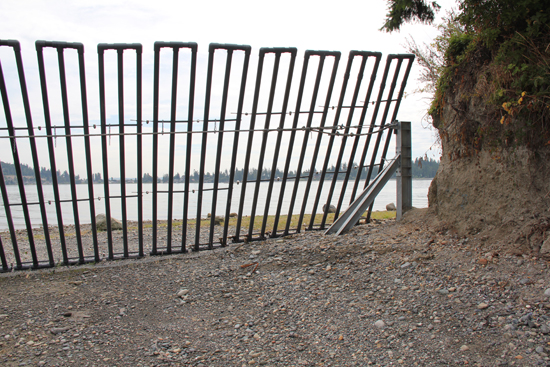Facility upgrades raise the survival rate

By Andrew Gobin, Tulalip News
Tulalip−Though marauding sea lions have been a constant nuisance to hatchery operations, it is now apparent they stand to threaten the success of hatchery runs as they have become more aggressive, pushing further upstream into holding areas for returning salmon. Through a series of upgrades to the facilities at the Bernie ‘Kai Kai’ Gobin Hatchery at Tulalip, changes are being made to optimize salmon returns.
Newly built sea lion fences at Battle Creek and below the hatchery dam and fish ladder prevent sea lions from going up stream, while allowing salmon to pass through.
“At low tide, the sea lions are belly-crawling up Battle Creek and taking females out of the holding area,” said Jesse Rude, hatchery assistant manager. “We can’t have a shortage of eggs, otherwise we have no fish to hatch.” Rude further noted that, “these fences are first of their kind. No other system like it is known to be used, or in existence.”
At the damn, a small pond with a barricade of rocks sits below the fish ladder, behind the new fence. This allows the salmon to get behind the fence where they are protected, while keeping the salmon from going upstream too early; another new technique the hatchery is trying. “Incidentally, this is good for the fishermen too, keeps the fish out in the bay to be caught,” noted Rude.
At the top of the ladder, a mechanized holding pen and fish lift are installed. The lift looks similar to a car elevator from a parking garage, and can lift comparable weight loads. This allows the salmon to be pulled out and processed more quickly than pitching fish by hand.
The last major upgrades were the installation of birdnetting, to keep birds from getting an easy meal in the lower ponds and creeks, and the new larger pond at the hatchery.
“With the larger pond, we are able to do a lot more Chinook,” said Rude, referring to larger quantities of eggs, and later smolt, that the pond can hold relative to the area needed to have a productive salmon hatch.
“Last year we hatched 1.5 million Coho, and we released a record 1.3 million fish.” Typically, the rate of survival is 50% to 60%; meaning only half of what is hatched actually gets released.
Ironically, the upgrades from 2005 and 2006 led to the record-breaking release of Coho. The snow built up on the birdnetting, breaking the nets and dragging the support posts, and the Jersey barriers that anchored them, into the fish ponds.
“We had to move all of the fish up to the new larger pond,” Rude explained. As a result, the Coho run was over-wintered, meaning they were more mature than normal when released.
They were free of predation back up in the pond as well. Rude said, “the otters are like rats in the ponds. They are everywhere and they eat the fish. The last couple of years we’ve had to hire predator control to manage the otters.”
When asked about the success of over-wintering and potential continuation, Rude said they would be trying similar methods with all of their runs this year.
Other upgrades include expanded feed and storage facilities, covered or shaded ponds, a concrete fish weir put in at Battle Creek, and expanding and repairing the birdnetting for all hatchery creeks and ponds.
